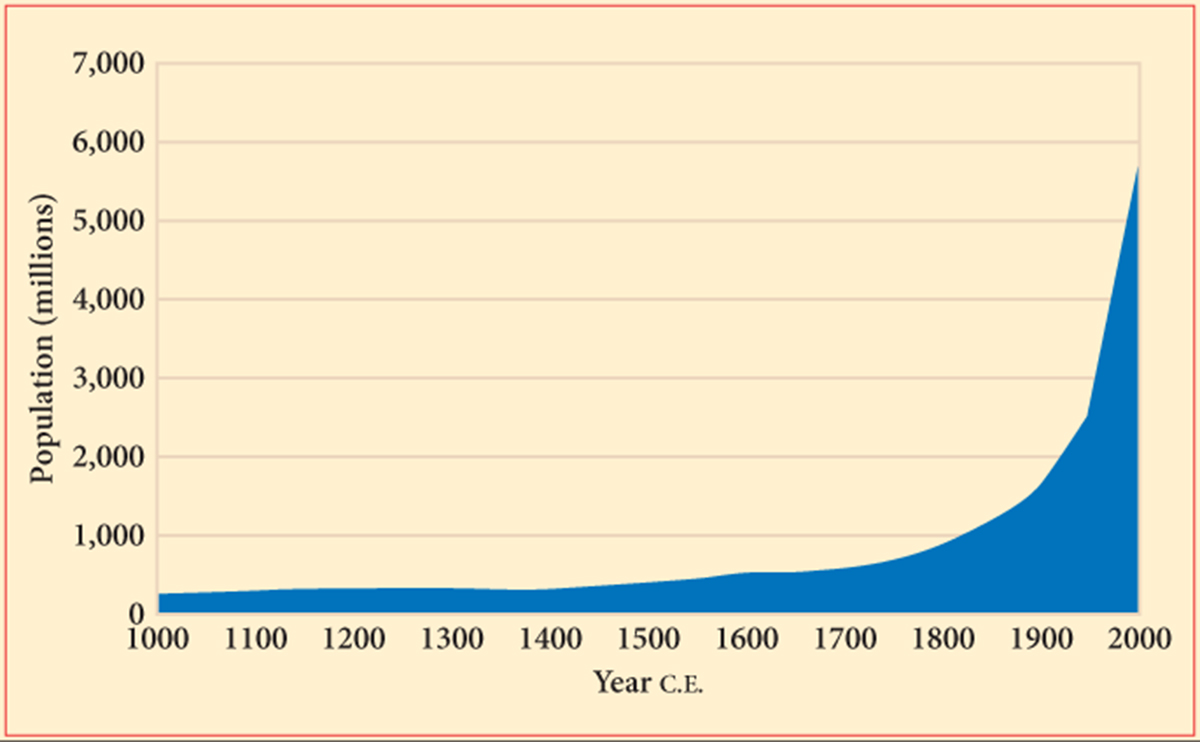A Preview of Coming Attractions: Looking Ahead to the Modern Era, 1500–2015
While ties of empire, culture, commerce, and disease surely linked many of the peoples in the world of the fifteenth century, none of those connections operated on a genuinely global scale. Although the densest webs of connection had been woven within the Afro-
Over those five centuries, the previously separate worlds of Afro-
Several centuries after the Columbian voyages, and clearly connected to them, a second distinctive feature of the modern era took shape: the emergence of a radically new kind of human society, first in Europe during the nineteenth century and then in various forms elsewhere in the world. The core feature of such societies was industrialization, with its sustained growth of technological innovation and its massive consumption of energy and raw materials. The human ability to create wealth made an enormous leap forward in a very short period of time, at least by world history standards. Accompanying this economic or industrial revolution was an equally distinctive and unprecedented jump in human numbers, a phenomenon that has affected not only human beings but also many other living species and the earth itself. (See Snapshot: World Population Growth.)
Moreover, these modern societies were far more urbanized and much more commercialized than ever before, as more and more people began to work for wages, to produce for the market, and to buy the requirements of daily life rather than growing or making those products for their own use. These societies gave prominence and power to holders of urban wealth—
SNAPSHOTWorld Population Growth, 1000–20002

Modern societies were generally governed by states that were more powerful and intrusive than earlier states and empires had been, and they offered more of their people an opportunity to play an active role in public and political life. Literacy in modern societies was far more widespread than ever before, while new national identities became increasingly prominent, competing with more local loyalties and with those of empire. To the mix of established religious ideas and folk traditions were now added the challenging outlook and values of modern science, with its secular emphasis on the ability of human rationality to know and manipulate the world. Modernity has usually meant a self-
This revolution of modernity, comparable in its pervasive consequences only to the Agricultural Revolution of some 10,000 years ago, introduced new divisions and new conflicts into the experience of humankind. The ancient tensions between rich and poor within particular societies were now paralleled by new economic inequalities among entire regions and civilizations and a much-
A third defining feature of the last 500 years was the growing prominence of European peoples on the global stage. In ancient times, the European world, focused in the Mediterranean basin of Greek culture and the Roman Empire, was but one of several second-
In the centuries following 1500, however, this western peninsula of the Eurasian continent became the most innovative, most prosperous, most powerful, most expansive, and most imitated part of the world. European empires spanned the globe. European peoples created new societies all across the Americas and as far away as South Africa, Australia, and New Zealand. Their languages were spoken and their Christian religion was widely practiced throughout the Americas and in parts of Asia and Africa. Their businessmen bought, sold, and produced goods around the world. It was among Europeans that the Scientific and Industrial Revolutions first took shape, with enormously powerful intellectual and economic consequences for the entire planet. The quintessentially modern ideas of liberalism, nationalism, feminism, and socialism all bore the imprint of their European origin. By the beginning of the twentieth century, Europeans or peoples of European descent exercised unprecedented influence and control over the earth’s many other peoples, a wholly novel experience in human history.
For the rest of the world, growing European dominance posed a common challenge. Despite their many differences, the peoples of Asia, Africa, the Middle East, the Americas, and Pacific Oceania all found themselves confronted by powerful and intrusive Europeans. The impact of this intrusion and how various peoples responded to it—